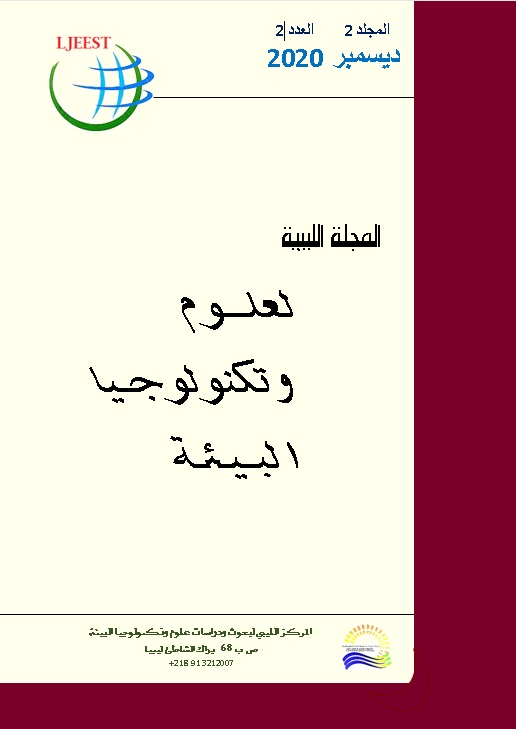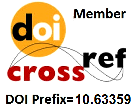فحص وتوصيف الفطريات الشعاعية البحرية المعزولة من شاطئ الخمس
DOI:
https://doi.org/10.63359/46769y18الكلمات المفتاحية:
مضادات الميكروبات، منطقة التثبيط، الفطريات الشعاعية البحرية، الرواسب، المستقلبات الثانويةالملخص
لقد أصبحت ظاهرة ظهور السلالات المقاومة للمضادات الحيوية وانتشارها في المستشفيات من المشاكل التي تواجه العلماء والباحثين. ومع اكتشاف المركبات الأيضية الثانوية الفعالة من بعض الأحياء الدقيقة في البيئة المحيطة من حولنا خاصة البيئة البحرية التي تساهم بشكل واضح لمنع ظهور هذه السلالات المقاومة للمضادات الحيوية. تهدف هذه الدراسة إلى عزل هذه مركبات الأيضية الثانوية الفعالة من البكتريا الموجبة لصبغة جرام ( الاكتينومايسيتات) والتي عزلت من رمال شاطئ مدينة الخمس ليبيا, وبواقع ثلاث أعماق مختلفة, وباستخدام بيئات غذائية مختلفة. تم الحصول علي خمس عزلات من أصل عشرون عزلة رمز لها1 HSEH1 إلي HSEH 20 أثبتت تأثيرها الفعال ضد الأحياء الدقيقة الممرضة مثل الخميرة Candida albicance، والبكتريا (Staphylococcus aureu ،Salmonella typhi, Escherichia coli و Klebcella pneumonia) حيث كان وسطSabouraud Dextrose Agar هو الوسط الغذائي الأفضل لإظهاره الخصائص التضادية للمركبات الحيوية الفعالة التي تنتجها عزلات الاكتينومايسيتات ,في حين أنها أظهرت هذه العزلات منطقة تثبيط واضحة ضد هذه الممرضات علي الوسط الغذائي Mueller-Hinton agar بطريقة نشر القرص. أثبتت نتائج هذه الدراسة أن العزلات الخمسة لها قدرة على تثبيط الممرضات من خلال منطقة التثبيط التي حول كل مستعمرة وبرهنت أن أفضلها العزلة HSEH16 وفقا للخواص والاختبارات البيوكيميائية ونشاطها الجرثومي الواسع ضد الممرضات المستخدمة في هذه الدراسة. من خلال هذه الدراسة يتبين ضرورة مواصلة البحث مستقبلا في الخواص التضادية لهذه العزلات وخصوصا 6 HSEH1 وتعريفها، ومعرفة خواص المواد الفعالة التي تنتجها, لما لها من دور فعال ومهم يخدم عملية الحفاظ على صحة البشرية.
المراجع
Abo-Shadi M., Sidkey N.M., and Al-Mutrafy A.M. (2010). Antimicrobial agent producing microbes from some soils rhizosphere. Journal of American Science. 6(10), 915–925.
AitBarka E., Vatsa P., Sanchez L., Gaveau-Vaillant N., Jacquard C., Klenk H-P., Clément C., Ouhdouch Y., and Van Wezel G.P. (2016). Taxonomy, physiology, and natural products of Actinobacteria. Microbiology and molecular biology reviews. 80:1- 43.
Berdy J. (2005). Bioactive microbial metabolites. Journal of Antibiotic. 58: 1-26.
Berdy J. (2012). Thoughts and Facts About Antibiotics: Where We Are Now And Where We Are Heading. Journal of Antibiotics. 65: 385-395.
Bergeys manual of determinative bacteriology, (2000). Actinomyceteles 9th edition.
Cayol J.L., Ollivier B., Alazard D., Amils R., Godfroy A., Piette F., and Prieur D (2015). The Extreme Conditions of Life on the Planet and Exobiology. Environmental Microbiology Fundamentals and Application Microbial Ecology pp. 353-394.
Ceylan O., Okmen G., and Ugar A. (2008). Isolation of soil Streptomyces as source of antibiotics active against antibiotic-resistant bacteria, Eurasian Journal of BioSciences. 2:73-82.
Demain A. L., and Sanchez S. (2009). Microbial drug discovery: 80 years of progress, Journal of Antibiotic. 62:5-16.
Derosa S., Mitova M. and Tommonero G. (2003). Marine bacteria associated with sponges as a sources of cyclic peptides. Biomolecular Engineering 20: 311-316.
Dopazo C.P., Lemos M.L., Lodeiros C., Bolinches J., Barja J. and Toranzo A. E. (1988). Inhibitory activity of antibiotic producing marine bacteria against fish pathogens. Journal of Applied Bacteriology 65: 97-101.
Harwani D. (2013). Biodiversity of Rare Thermophilic Actinomycetes Inthegreat Indian Thar Desert: An overview in doam. Journal of Pharmaceutical Research. 3: 934-939.
Hayakawa M., Ishiwwa K., and Nonomurha H. (2004). Distribution of rare actinomycetes in Japanese soils. Journal of Fermentation and Bioengineering. 66:367–373
Hong, S., Ryu, H. W., Kim, J. & Cho, K. S. 2011. Rhizoremediation of diesel contaminated soil using the plant growth promoting rhizobacterium Gordonia sp. S2RP-17. Biodegradation 22:593-601.
Lee D. W., Lee J. M., Seo J. P., Schumann P., Kim S.J. and Lee S.D. (2010). Phycicolagilvus gen. Nov., an actinobacterium isolated from living seaweed. International Journal of Systematic and Evolutionary Microbiology. 58:1318-1323.
Lemos M. L., Toranzo A. E. and Barja J. L. (1985). Antibiotic activity of epiphytic bacteria isolated from intertidal seaweeds. Microbial Ecology.11:149-163.
Marit H. S., Kjell D. J., Geir K. A., Svein V., Trond E.E. and Per B. (2010). Isolation and characterization of marine pigmented bacteria from Norwegian Coastal waters and screening for carotenoids with UVA-Blue light absorbing properties. The Journal of Microbiology 48(1):16-23.
Matsumoto D., Takeuchi S., Andayani S., Kouznetsova N., and Krupp D. (1998). The contribution of Individualism-collectivism to cross-national differences in display rules. Asian Journal of Social Psychology. 1:147-165.
McCarthy S. A., Johnson R. M. and Kakimoto D. (1994). Characterization of an antibiotic produced by Alteromonas luteoviolacea Gauthier 1982, 85 isolated from Kinko Bay, Japan. Journal of Applied Bacteriology 77: 426-432.
Miyadoh S. (1993). Research on antibiotic screening in Japan over the last decade: a producing microorganisms approach, Actinomycetol. 7:100-106.
Mohammadipanah F. and Wink J. (2016). Actinobacteria from Arid and Desert Habitats: Diversity and Biological Activity. Frontiers in Microbiology 6:1541.
Oskay M., Tamer A.Ü. and Azeri C. 2004. Antibacterial activity of some actinomycetes isolated from farming soils of Turkey. African Journal of Biotechnology. 3: 441-446.
Pickup K.M., Nolan R.D. and Bushell M.E. (1993). A method for increasing the success rate of duplicating antibiotic activity in agar and liquid cultures of Streptomyces isolates in new antibiotic screens, Journal of Fermentation and Bioengineering. 76: 89-93.
Raytapadar S. and Paul A.K. ( 2001). Production of an antifungal antibiotic by Streptomyces aburaviensis (1DA-28), Microbiology Research. 155:315-323.
Richa S. and Vivek S. (2018). The Role of Actinobacteria in the Production of Industrial Enzymes. New and Future Developments in Microbial Biotechnology and Bioengineering pp. 165-177.
Saadoun I., Al-Joubori B. and Al-Khoury R. (2015). Testing of Production of Inhibitory Bioactive Compounds by Soil Streptomycetes as Preliminary Screening Programs In UAE For Anti-Cancer and Anti-Bacterial Drugs. international journal of current microbiology and applied sciences. 4(3):446-459.
Shantikumar L., Baruah I. and Bora T.C.(2006). Actinomycetes of loktak habitat:Isolation and Screening for Antimicrobial Activities.Biotechnology. 5:217-221.
Shomurat T., Yoshida J., Amano S., Kojina, M. and Niida T. (1979). Studies on actinomycetal producing antibiotics only in agar culture. I. Screening taxonomy and morphology productivity relationship of Streptomyces halstedii, strain SF. Journal of. Antibiotics, 32: 427-435.
Singh L.S., Baruah I. and Bora T.C. (2006). Actinomycetes of Loktak and Habitat: Isolation and screening for antimicrobial activities. Biotechnology. 5:217-221.
Tiwari K. and Gupta R.K. (2012). Rare Actinomycetes: A Potential Storehouse For
















